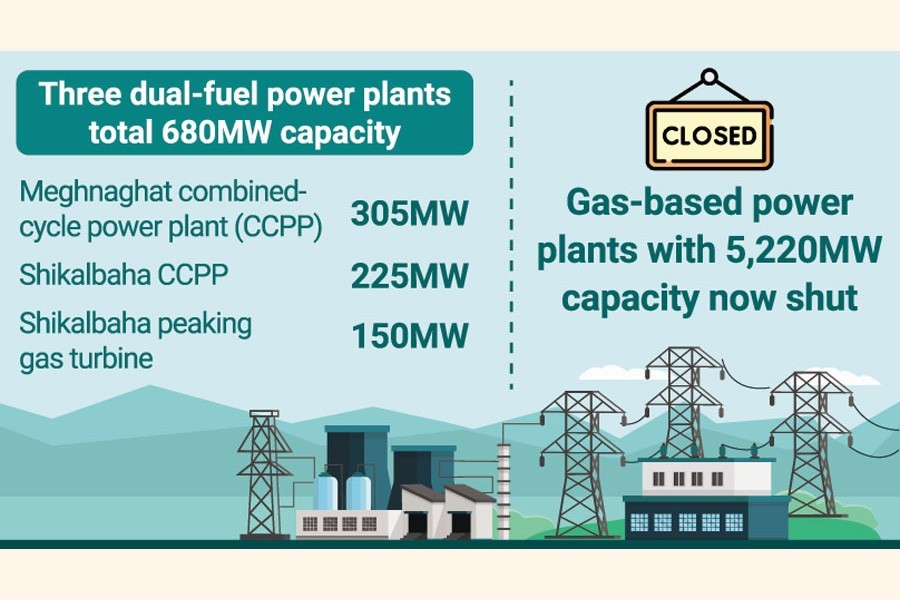
Published :
Updated :

The current gas-fired dual-fuel power plants are likely to be run by diesel in an expensive energy substitution for gas crunch principally for exploration dilemmas, officials indicate.
To make do with the limited output, the gas saved from power- production sector will be supplied to industries many of which now rue gas-supply shortages.
"We are considering running the dual-fuel power plants by diesel again to tackle the ongoing natural gas crisis," says State Minister for the Ministry of Power, Energy and Mineral Resources (MPEMR) Nasrul Hamid.
The gas to be saved from supply cuts to power plants might be supplied to industries as businessmen are demanding increased supply of natural gas to run their industries, he told the FE Monday.
A high-powered committee constituted by the MPEMR also echoes the similar view.
The decision will help the government mitigate the natural gas crisis on ad-hoc basis but, at the same time, increase the cost of producing electricity significantly, says energy-expert Prof M Tamim.
He, however, opines that the government does not have any way out in sight as it did not carry out necessary oil-and gas-exploration activities in the past to increase the country's overall gas supply.
Sources said the government in late April 2019 had turned the then diesel-fired dual-fuel power plants into gas-fired ones as the overall supply of natural gas increased with the start of operation of the country's second floating, storage and re-gasification unit (FSRU) and re-gasification of liquefied natural gas (LNG) subsequently.
Three dual-fuel power plants having the total electricity- generation capacity of around 680 megawatts--Meghnaghat 305MW combined-cycle power plant (CCPP), Shikalbaha 225MW CCPP and Shikalbaha 150MW peaking gas turbine--are running on re-gasified LNG (R-LNG) now.
All these three dual-fuel power plants will run on diesel instead of natural gas in line with latest government strategy shift.
Around 100 million cubic feet per day (mmcfd) of additional natural gas could be supplied to industries as an outcome of the substitution perforce.
The government committee on finding a way out of the gas crisis also recommended increasing electricity generation from oil-fired power plants through augmenting the use of diesel and furnace oil, a senior official of the state-run Bangladesh Power Development Board (BPDB) told the FE.
This new measure will also help increase the country's electricity generation during the upcoming summer when the overall demand for electricity might exceed around 15,000 megawatts, said the BPDB official.
The highest electricity generation so far was recorded 13,792MW during last summer.
Country's overall natural gas output is hovering around 2,745 mmcfd which is far outstripped by an overall demand for around 4,000 mmcfd.
A couple of dozen gas-fired power plants are now shut as the state-run Petrobangla could supply around 730mmcfd natural gas to power plants against their 2,252mmcfd demand.
Gas-fired power plants having the generation capacity of around 5,220MW are now shut mostly due to gas crisis.
Most of the furnace oil-and diesel-fired power plants are already in operation now.
Eight furnace oil-fired plants with a combined 650MW-generation capacity are now shut while 48 such plants are now generating electricity.
Three diesel-fired units with a combined generation capacity of around 266MW are now out of operation while five others are on line, according to BPDB.
Dwindling natural gas supplies from local fields and inadequate LNG (liquefied natural gas) imports limited the availability of the fuel for industries, power plants and other consumers.
Exorbitant LNG price globally and non-operation of one of the two FSRUs (floating storage and regasification unit) also squeezed LNG imports from the international market only to feed into the gas crisis.
Country's overall LNG re-gasification capacity halved due to rupture in 'mooring line' of Group's FSRU since November 2021.
Ship-to-ship transfer of the liquefied natural gas of the FSRU remained suspended till then.
The LNG re-gasification is at present dependent on US's Excelerate Energy's FSRU, amounting to around 400 mmcfd compared to usual supplies of around 800mmcfd.
Azizjst@yahoo.com


 For all latest news, follow The Financial Express Google News channel.
For all latest news, follow The Financial Express Google News channel.